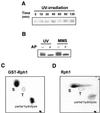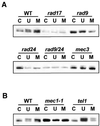Phosphorylation of Rph1, a damage-responsive repressor of PHR1 in Saccharomyces cerevisiae, is dependent upon Rad53 kinase
- PMID: 11809875
- PMCID: PMC100300
- DOI: 10.1093/nar/30.3.643
Phosphorylation of Rph1, a damage-responsive repressor of PHR1 in Saccharomyces cerevisiae, is dependent upon Rad53 kinase
Abstract
Rph1, a Cys2-His2 zinc finger protein, binds to an upstream repressing sequence of the photolyase gene PHR1, and represses its transcription in response to DNA damage in Saccharomyces cerevisiae. In this report, we have demonstrated that the phosphorylation of Rph1 protein was increased in response to DNA damage. The DNA damage-induced phosphorylation of Rph1 was missing in most damage checkpoint mutants including rad9, rad17, mec1 and rad53. These results indicate that Rph1 phosphorylation is under the control of the Mec1-Rad53 damage checkpoint pathway. Rph1 phosphorylation required the kinase activity of Rad53 since it was significantly decreased in rad53 checkpoint mutant. Furthermore, loss of other kinases including Dun1, Tel1 and Chk1, which function downstream of Mec1, did not affect the Rph1 phosphorylation. This contrasts with the derepression of Crt1-regulated genes, which requires both Rad53 and Dun1 protein kinases. These results imply that post-translational modification of Rph1 repressor is regulated by a potentially novel damage checkpoint pathway that is distinct from the RAD53-DUN1-CRT1 cascade implicated in the DNA damage-dependent transcription of ribonucleotide reductase genes.
Figures



Similar articles
-
The histone H3K36 demethylase Rph1/KDM4 regulates the expression of the photoreactivation gene PHR1.Nucleic Acids Res. 2011 May;39(10):4151-65. doi: 10.1093/nar/gkr040. Epub 2011 Feb 3. Nucleic Acids Res. 2011. PMID: 21296759 Free PMC article.
-
Ixr1 is required for the expression of the ribonucleotide reductase Rnr1 and maintenance of dNTP pools.PLoS Genet. 2011 May;7(5):e1002061. doi: 10.1371/journal.pgen.1002061. Epub 2011 May 5. PLoS Genet. 2011. PMID: 21573136 Free PMC article.
-
Role of UME6 in transcriptional regulation of a DNA repair gene in Saccharomyces cerevisiae.Mol Cell Biol. 1997 Nov;17(11):6223-35. doi: 10.1128/MCB.17.11.6223. Mol Cell Biol. 1997. PMID: 9343383 Free PMC article.
-
Role of the Saccharomyces cerevisiae Rad9 protein in sensing and responding to DNA damage.Biochem Soc Trans. 2003 Feb;31(Pt 1):242-6. doi: 10.1042/bst0310242. Biochem Soc Trans. 2003. PMID: 12546694 Review.
-
Phosphatases, DNA damage checkpoints and checkpoint deactivation.Cell Cycle. 2007 Dec 15;6(24):3058-64. doi: 10.4161/cc.6.24.5100. Epub 2007 Sep 20. Cell Cycle. 2007. PMID: 18075314 Review.
Cited by
-
Epigenetic silencing mediates mitochondria stress-induced longevity.Cell Metab. 2013 Jun 4;17(6):954-964. doi: 10.1016/j.cmet.2013.04.003. Cell Metab. 2013. PMID: 23747251 Free PMC article.
-
Cbk1 kinase and Bck2 control MAP kinase activation and inactivation during heat shock.Mol Biol Cell. 2011 Dec;22(24):4892-907. doi: 10.1091/mbc.E11-04-0371. Epub 2011 Oct 26. Mol Biol Cell. 2011. PMID: 22031291 Free PMC article.
-
An optogenetic switch for the Set2 methyltransferase provides evidence for transcription-dependent and -independent dynamics of H3K36 methylation.Genome Res. 2020 Nov;30(11):1605-1617. doi: 10.1101/gr.264283.120. Epub 2020 Oct 5. Genome Res. 2020. PMID: 33020206 Free PMC article.
-
Live longer on MARS: a yeast paradigm of mitochondrial adaptive ROS signaling in aging.Microb Cell. 2014 Apr 23;1(5):140-144. doi: 10.15698/mic2014.05.143. Microb Cell. 2014. PMID: 28357235 Free PMC article. Review.
-
Life in the midst of scarcity: adaptations to nutrient availability in Saccharomyces cerevisiae.Curr Genet. 2010 Feb;56(1):1-32. doi: 10.1007/s00294-009-0287-1. Curr Genet. 2010. PMID: 20054690 Review.
References
-
- Zhou B.B. and Elledge,S.J. (2000) The DNA damage response: putting checkpoints in perspective. Nature, 408, 433–439. - PubMed
-
- Cortez D., Wang,Y., Qin,J. and Elledge,S.J. (1999) Requirement of ATM-dependent phosphorylation of Brca1 in the DNA damage response to double-strand breaks. Science, 286, 1162–1166. - PubMed
-
- Gatei M., Young,D., Cerosaletti,K.M., Desai-Mehta,A., Spring,K., Kozlov,S., Lavin,M.F., Gatti,R.A., Concannon,P. and Khanna,K. (2000) ATM-dependent phosphorylation of nibrin in response to radiation exposure. Nature Genet., 25, 115–119. - PubMed
-
- Zhao S., Weng,Y.C., Yuan,S.S., Lin,Y.T., Hsu,H.C., Lin,S.C., Gerbino,E., Song,M.H., Zdzienicka,M.Z., Gatti,R.A., Shay, J.W., Ziv,Y., Shiloh,Y. and Lee,E.Y. (2000) Functional link between ataxia-telangiectasia and Nijmegen breakage syndrome gene products. Nature, 405, 473–477. - PubMed
-
- Elledge S.J. (1996) Cell cycle checkpoints: preventing an identity crisis. Science, 274, 1664–1672. - PubMed
Publication types
MeSH terms
Substances
LinkOut - more resources
Full Text Sources
Molecular Biology Databases
Research Materials
Miscellaneous

